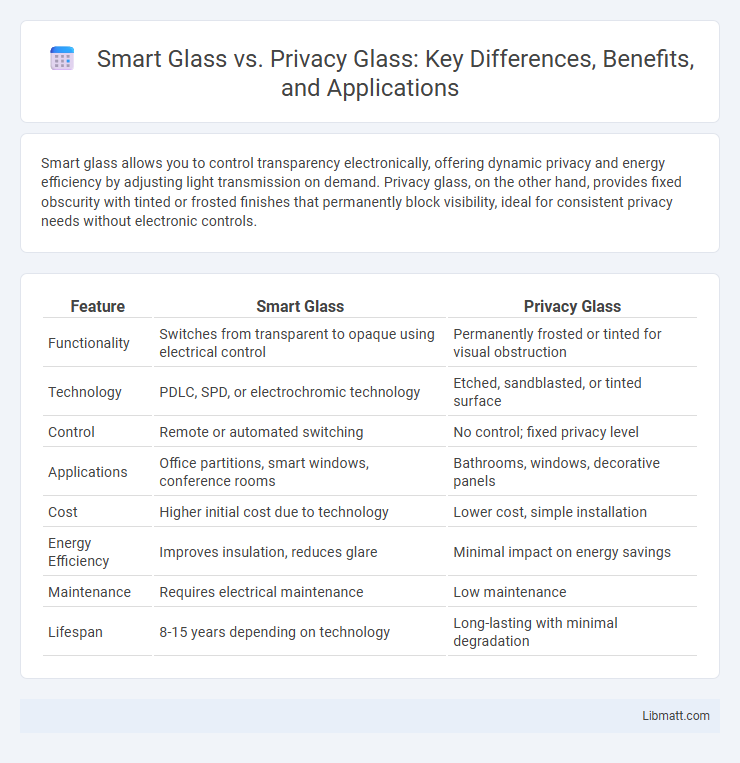Smart glass allows you to control transparency electronically, offering dynamic privacy and energy efficiency by adjusting light transmission on demand. Privacy glass, on the other hand, provides fixed obscurity with tinted or frosted finishes that permanently block visibility, ideal for consistent privacy needs without electronic controls.
Table of Comparison
| Feature | Smart Glass | Privacy Glass |
|---|---|---|
| Functionality | Switches from transparent to opaque using electrical control | Permanently frosted or tinted for visual obstruction |
| Technology | PDLC, SPD, or electrochromic technology | Etched, sandblasted, or tinted surface |
| Control | Remote or automated switching | No control; fixed privacy level |
| Applications | Office partitions, smart windows, conference rooms | Bathrooms, windows, decorative panels |
| Cost | Higher initial cost due to technology | Lower cost, simple installation |
| Energy Efficiency | Improves insulation, reduces glare | Minimal impact on energy savings |
| Maintenance | Requires electrical maintenance | Low maintenance |
| Lifespan | 8-15 years depending on technology | Long-lasting with minimal degradation |
Understanding Smart Glass: Definition and Technology
Smart glass, also known as switchable glass, uses advanced technology such as electrochromic, thermochromic, or photochromic materials to change its transparency in response to electrical, heat, or light stimuli. Unlike privacy glass, which is typically tinted or frosted to provide a constant level of opacity, smart glass offers dynamic control over visibility and light transmission, enhancing energy efficiency and user comfort. Your choice between smart glass and privacy glass depends on the desired balance of adaptability, privacy, and energy savings for your space.
What is Privacy Glass? Key Features Explained
Privacy glass, also known as tinted or frosted glass, is designed to limit visibility and enhance confidentiality by reducing transparency and blocking light. Key features include UV protection, glare reduction, and the ability to maintain a sleek aesthetic without compromising natural light. Your choice of privacy glass can significantly improve comfort and security in vehicles or architectural spaces while preserving privacy.
How Smart Glass Works: Mechanisms and Applications
Smart glass operates by adjusting its opacity or transparency through embedded technologies like liquid crystals, electrochromic layers, or suspended particle devices (SPDs). These mechanisms enable instant modulation of light transmission when an electric current is applied, allowing control over visibility and heat. Your space benefits from this dynamic functionality in applications ranging from energy-efficient windows to adaptive privacy solutions, unlike static privacy glass which simply maintains a constant opaque state.
Privacy Glass: How It Provides Confidentiality
Privacy glass provides confidentiality by utilizing electrochromic technology that allows you to switch its transparency on demand, effectively controlling visibility into your space. Unlike traditional glass, it can instantly transition from clear to frosted or opaque, ensuring private environments in offices, homes, or vehicles without compromising natural light. This dynamic feature makes privacy glass a highly efficient solution for maintaining discretion and reducing exposure to external observation.
Comparing Smart Glass and Privacy Glass: Key Differences
Smart glass uses electrochromic technology to switch between transparent and opaque states, offering dynamic control over light and privacy, while privacy glass remains permanently tinted or frosted to provide constant obscurity. Smart glass enhances energy efficiency and adaptability in buildings and vehicles, whereas privacy glass offers a cost-effective, fixed solution for shading and concealment. Your choice depends on whether you prefer customizable opacity with smart glass or a simple, permanent privacy solution with privacy glass.
Advantages of Smart Glass in Modern Architecture
Smart glass offers dynamic control over natural light and privacy, enhancing energy efficiency in modern architecture by reducing reliance on artificial lighting and HVAC systems. Its ability to switch between transparent and opaque states improves occupant comfort and spatial flexibility without compromising aesthetic design. Integration of smart glass technology also supports sustainable building practices by minimizing heat gain and loss, contributing to LEED certification and reducing overall carbon footprint.
Privacy Glass Benefits: Enhanced Security and Seclusion
Privacy glass delivers enhanced security by obscuring the interior from outside view, reducing the risk of theft and unauthorized access. Its seclusion benefits provide a controlled environment, ideal for confidential meetings or personal spaces without visual distractions. You gain peace of mind knowing your privacy is protected without compromising on natural light.
Cost Comparison: Smart Glass vs Privacy Glass
Smart glass typically costs between $50 to $100 per square foot, making it a higher investment compared to privacy glass, which ranges from $20 to $50 per square foot. Installation expenses for smart glass can be more complex due to the need for electrical wiring and control systems, while privacy glass installation is generally straightforward. Long-term costs of smart glass include energy savings and enhanced functionality, whereas privacy glass mainly provides passive light control without additional operational costs.
Use Cases: Where to Install Smart or Privacy Glass
Smart glass is ideal for office partitions, conference rooms, and residential windows where adjustable light control and privacy on demand enhance comfort and energy efficiency. Privacy glass is commonly installed in bathrooms, medical facilities, and vehicle windows to maintain constant opacity and secure personal spaces. Your choice depends on whether you require dynamic transparency or permanent privacy in specific environments.
Choosing Between Smart Glass and Privacy Glass: Factors to Consider
Choosing between smart glass and privacy glass depends on factors such as desired control over transparency, energy efficiency, and installation costs. Smart glass offers adjustable opacity through electronic control, enhancing energy savings and dynamic privacy, while privacy glass provides fixed opacity for consistent privacy at a lower price. Consider application needs, budget, and maintenance requirements to determine the best option for residential, commercial, or automotive use.
Smart glass vs privacy glass Infographic

 libmatt.com
libmatt.com